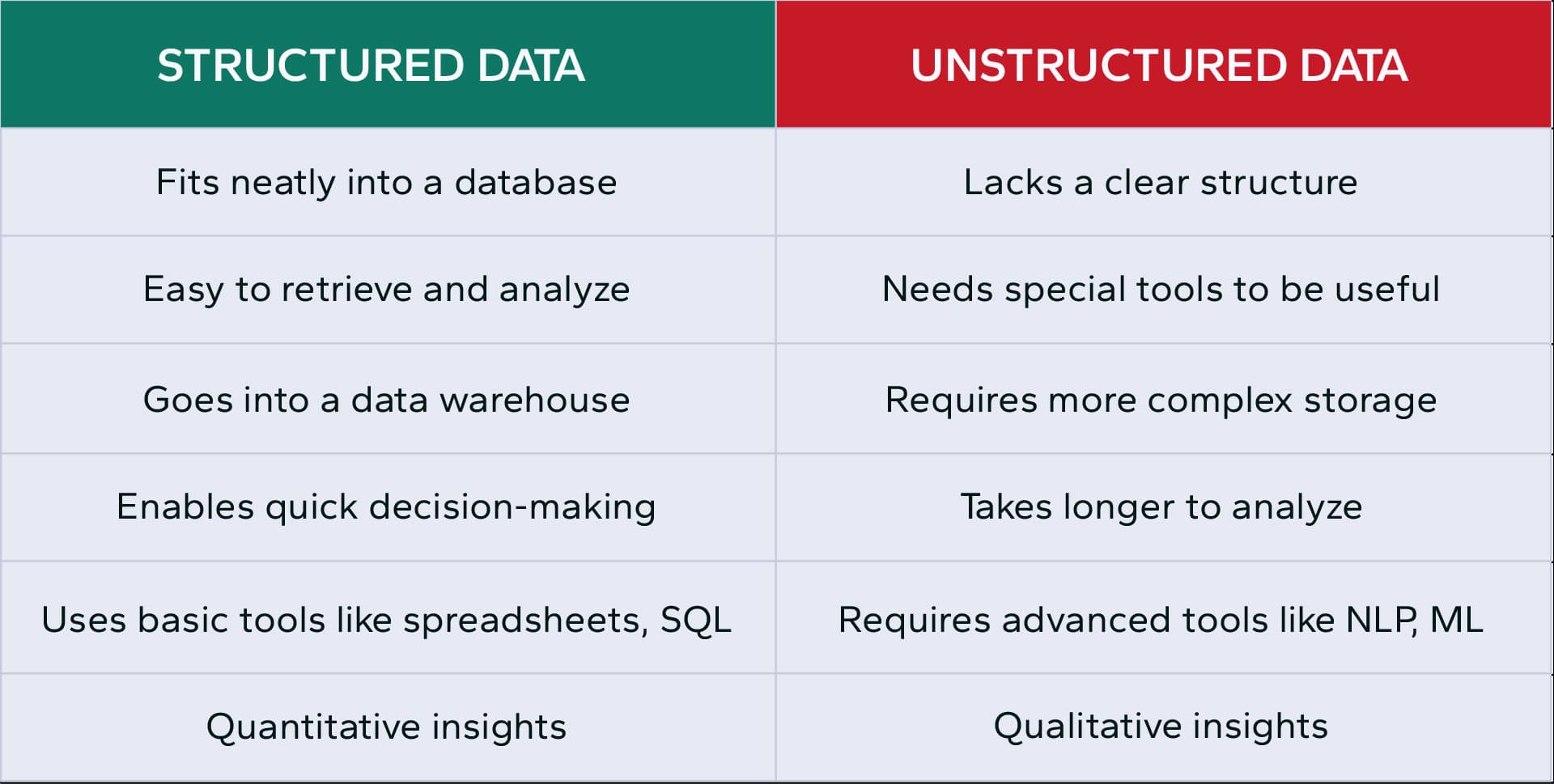Data is classified into two main types: structured and unstructured. Structured data refers to organized information that follows a predefined format and resides in fixed fields within a record or file. It’s easily searchable, organized, and can be stored in databases.
Unstructured data, on the other hand, lacks a specific structure and doesn’t fit neatly into databases. Understanding the differences between these classifications is a foundational aspect of any modern data management strategy.
Let’s delve into the nuances of structured and unstructured data, to explore the definitions, examples and roles each data type plays in analytics, decision-making, and organizational growth.
What is Structured Data?
Structured data is the most organized type of data, fitting neatly into predefined formats like databases with rows and columns. It’s easy to search, analyze, and use because of its well-ordered structure. This makes it ideal for quick data processing, which is why structured data is so critical for many business operations.
Structured data shows up in all kinds of industries. In finance, it could be transaction records and stock market data. In healthcare, think of patient records and diagnostic reports. For e-commerce, product catalogs and customer purchase histories fall under structured data.

Main Characteristics of Structured Data
Clear Organization
Structured data follows a specific format, stored in fixed fields within databases. It’s easily searchable and categorized, which helps you find what you need without much hassle.
Maintains Relationships
Structured data often has built-in relationships between data points. For example, customer records may link directly to purchase histories. This ensures your data stays consistent and reliable.
Effortless Analysis
Because structured data is so well organized, you can quickly run queries and analyze it. Whether you’re pulling sales figures or reviewing customer data, structured data makes the process faster.
Easy to Process
Structured data’s predefined structure makes processing straightforward. It’s simple to compute and manipulate, helping you work efficiently with data.
Structured Data Examples
These examples show how structured data is used to support critical functions and improve decision-making across industries.
- Finance: Structured data in finance includes transaction records, stock market data, and financial reports. This data is essential for analyzing market trends, managing investment risks, and running financial models.
- Healthcare: Patient records, diagnostic reports, and medical histories are structured data. These records help provide consistent patient care, streamline diagnoses, and support medical research through structured analysis.
- E-commerce: Product catalogs, customer purchase histories, and inventory databases are all structured data in e-commerce. This data helps you create personalized marketing, manage inventory, and improve customer service.
- Education: In educational institutions, structured data includes student records, test scores, and course enrollment data. This information helps track student progress, manage academic programs, and facilitate personalized learning paths.
- Retail: Structured data in retail includes sales transactions, product SKUs, and customer loyalty information. This data helps retailers manage inventory, analyze sales patterns, and design targeted promotions to improve customer satisfaction.
Common Uses of Structured Data
Due to its organized and easily accessible format, structured data offers numerous applications. Here are three common uses:
- Business Intelligence: Companies rely on structured data for business insights, analyzing customer behavior, sales trends, and financial performance to make data-driven decisions.
- Improving Efficiency: In industries like manufacturing and logistics, structured data automates processes like inventory management and shipment tracking, helping you streamline operations.
- Customer Relationship Management (CRM): Structured data powers CRM systems, tracking customer interactions and preferences so you can deliver personalized marketing and enhance customer service.
Technologies for Structured Data
Structured data, with its organized format, relies heavily on traditional relational databases like SQL and MySQL, which are designed to store data in rows and columns for easy access and retrieval. These databases allow for efficient querying and analysis, making it simple to manage structured datasets such as transaction records or customer information.
Enterprise resource planning (ERP) systems and customer relationship management (CRM) platforms also leverage structured data to streamline operations and improve decision-making.
Additionally, business intelligence (BI) tools like Tableau and Power BI are often used to analyze structured data so you can create reports and visualizations that drive actionable insights.
Furthermore, structured data technologies benefit from their predictability and scalability, and because the data is already organized, it can be easily integrated with other systems, allowing organizations to process and use it with minimal complexity.
Challenges With Structured Data
These challenges show that while structured data is powerful, it can still require careful planning and resources to manage effectively. Here are some common issues you might face:
Inflexible Structure
Structured data is rigid by nature. Changing the format or adding new data often means you’ll need to adjust the entire database, which can slow things down. This lack of flexibility makes it harder to adapt to new business needs or evolving data formats and creates roadblocks in your workflow.
Difficulty Sharing Data Across Systems
Sharing structured data between systems isn’t always easy. Different platforms often use different formats or schemas, so even though tools like SQL exist, inconsistencies in how data is represented can make data sharing tricky.
Managing Large Data Volumes
Structured data works well in smaller, organized datasets, but as your data grows, keeping up with it can be expensive and complex. Scaling databases requires more infrastructure and processing power, which can be tough to manage as data volumes explode in today’s fast-paced world.
What is Unstructured Data?
Unstructured data doesn’t fit neatly into a predefined format like structured data does. It’s more like freeform data—think text documents, images, videos, or social media posts. Since unstructured data doesn’t have an organized structure, it’s harder to search, analyze, and manage. However, it often holds valuable insights that can enhance business decision-making when properly processed.
Unstructured data is everywhere. In emails, you’ll find it in the content of the messages. In healthcare, it could be doctor’s notes or medical images. In media, think of audio and video files or even social media updates.
Main Characteristics of Unstructured Data
Lack of Organization
Unstructured data isn’t stored in a predefined format or organized into fields. This makes it harder to search and categorize, but it also offers a lot of flexibility for capturing diverse types of information.
No Predefined Relationships
Unlike structured data, unstructured data doesn’t maintain built-in relationships between different data points. You’ll need advanced tools, like AI, to draw connections between various pieces of unstructured data.
Shelf’s unstructured data management platform has tools to make your data gen-AI ready.
Complex to Analyze
Because it’s not neatly organized, unstructured data requires more advanced methods for analysis. You’ll often need artificial intelligence or machine learning models to extract meaning from unstructured content like videos or customer reviews.
Challenging to Process
Processing unstructured data is more time-consuming because there’s no standardized format. You’ll need sophisticated algorithms and tools to clean, sort, and analyze it, making it more resource-intensive than structured data.
Unstructured Data Examples
Unstructured data comes in a variety of formats and appearing in many industries:
- Healthcare: Doctor’s notes, medical images like X-rays or MRIs, and patient comments are all examples of unstructured data in healthcare. These require advanced tools to analyze but hold critical information for patient care.
- Media and Entertainment: Audio files, video content, and social media posts are key examples. Extracting insights from these types of data requires specialized software capable of handling text, audio, and visual analysis.
- Legal Documents: Contracts, legal briefs, PDF documents, audio recordings, and case files are unstructured data in the legal field. These documents contain a wealth of information, but extracting key details requires advanced natural language processing (NLP) techniques.
- Retail: Customer reviews, product images, and social media post content are examples of unstructured data in retail. Analyzing this type of data can help businesses understand customer sentiment and improve their products.
- Customer Support: Emails, chat logs, and support tickets are unstructured data in customer service. Analyzing these can help improve customer satisfaction by identifying common issues and trends.
Common Uses For Unstructured Data
Despite its complexity, unstructured data is extremely valuable. Here are some ways it’s used:
- Sentiment Analysis: You can analyze customer reviews, social media comments, or survey responses to gauge customer sentiment and refine your offerings.
- Content Recommendation: In media and entertainment, unstructured data like user preferences and viewing habits can be used to recommend content based on past behavior.
- Fraud Detection: Financial institutions use unstructured data like emails, transaction notes, and social media activity to detect fraud or other suspicious activities.

Technologies for Unstructured Data
Unstructured data requires more advanced technologies due to its complexity and lack of organization. But while these technologies make it more accessible, they often require significant computational power and specialized tools.
One key technology is natural language processing (NLP), which enables machines to understand and analyze text-based data such as emails, social media posts, PDF documents, and customer reviews. NLP tools can extract meaning, identify sentiment, and even translate languages, making unstructured data more usable.
Additionally, computer vision is crucial for interpreting images and videos. This allows you to analyze visual content for insights.
For large-scale unstructured data, data lakes and cloud-based storage solutions are often used, providing flexible environments to store and process vast amounts of information.
Finally, AI and machine learning models (like Shelf’s AI Assistants) are employed to find patterns, extract insights, and classify unstructured data, which helps you make better decisions based on diverse data sources.
Challenges With Unstructured Data
While unstructured data holds significant potential, it comes with its own set of challenges:
Lack of Organization
Unstructured data doesn’t have a clear and consistent format, which makes it tough to organize and categorize. Since there’s no predefined structure, storing, retrieving, and analyzing the data becomes much more complicated.
Huge Volume and Variety
Unstructured data comes in all sorts of formats—text, images, videos, and more. This creates a massive amount of information to handle. Managing such diverse types of data requires specialized tools that can process and interpret different formats.
Difficult to Analyze
Analyzing unstructured data isn’t easy. You’ll need advanced techniques like natural language processing (NLP) for text or computer vision for images. Extracting useful insights from this kind of data takes complex algorithms and a lot of computational power.
Quality and Accuracy Issues
Unstructured data often contains inconsistencies, errors, or irrelevant information. Ensuring that the data is clean and accurate is a challenge, especially when you’re dealing with large amounts of information from various sources.
Privacy and Security Risks
Unstructured data can contain sensitive information, which raises privacy and security concerns. Protecting this data from unauthorized access or breaches is critical, and you’ll need strong security measures to stay compliant with data regulations.
High Costs and Infrastructure Demands
Processing and storing unstructured data can be expensive. You’ll need to invest in infrastructure that can handle different types of data formats, and scaling up these systems can increase your costs significantly.
At-a-Glance: Comparing Structured Vs. Unstructured Data
| Category | Structured Data | Unstructured Data |
| Format | Organized in predefined formats like rows and columns | No predefined structure or format, freeform data |
| Storage | Stored in central repositories and relational databases with defined fields | Stored in data lakes, cloud storage, or NoSQL databases |
| Accessibility | Easily accessible and searchable due to predefined structure | Harder to search and access due to lack of organization |
| Examples | Transaction records, stock market data, product catalogs | Emails, images, social media posts, videos |
| Uses | Business intelligence, CRM, operational efficiency | Sentiment analysis, content recommendation, fraud detection |
| Analysis | Easier analysis with standard query languages (e.g., SQL) | Requires advanced techniques like NLP, computer vision |
| Flexibility | Less flexible, rigid schema makes changes difficult | Highly flexible, can accommodate various data types |
| Scalability | Scales well but requires careful planning for large datasets | Scales with advanced tools but is resource-intensive |
| Data Quality | High data quality due to enforced consistency and rules | Variable data quality, often includes inconsistencies or noise |
How Shelf Supports Your Data
Shelf is a comprehensive solution that manages both structured and unstructured data.
For structured data, Shelf integrates seamlessly with traditional databases and enterprise systems, such as CRMs, ERPs, and other tools where data is stored in an organized, structured format. It can pull data from these systems, categorize it, and make it easily accessible through its intelligent search features.
Shelf’s platform allows users to quickly query structured data, retrieve insights, and generate reports, improving operational efficiency and decision-making.
When it comes to unstructured data, Shelf uses AI-driven technologies like natural language processing and machine learning to handle documents, emails, multimedia files, and other forms of unstructured data.
By automatically tagging, classifying, and organizing this type of data, Shelf transforms chaotic information into a structured, searchable resource. Its intelligent search capabilities enable you to find specific pieces of information buried within unstructured content quickly.




